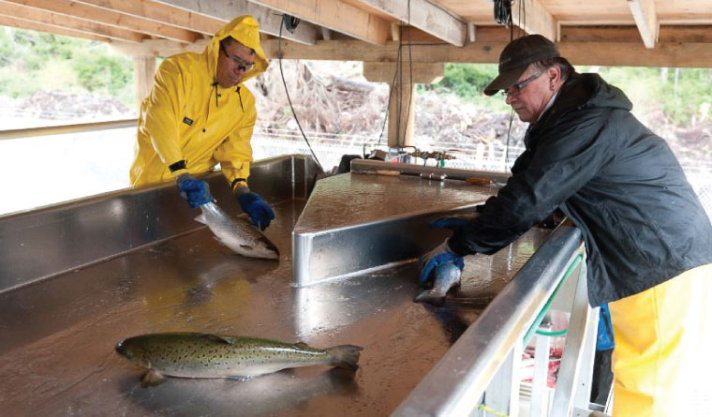
The first harvest of fish from Canada’s first land-based, closed containment Atlantic salmon farm is momentous but the initiative must still prove its mettle.
“Certainly there’s all the euphoria and a sense of success around getting it this far and all the hope associated with that, that we are hopefully able to catalyze industry in a way that is much more sustainable for the environment. And then on the other side there is the necessary trepidation and caution because we haven’t finished yet,” says Jackie Hildering, communications director with the SOS Marine Conservation Foundation, a project partner.
|
The referenced media source is missing and needs to be re-embedded.
|
|
| ’Namgis First Nation Chief Bill Cranmer presenting the first Kuterra salmon offered for sale to Renée Hopfner, director, corporate social responsibility for Safeway-Sobeys. |
“We are by no means done because the greater objective is to show that the economies and production advantages are enormous,” she says.
Working with SOS Marine Conservation Foundation and Tides Canada, the ’Namgis First Nation of Northern Vancouver Island launched the farm in March 2013 to prove the economies of growing Atlantic salmon sustainably, on land, separated from the marine environment. Just over a year later, on April 22, which is Earth Day, the farm’s first harvested salmon became available at Safeway stores in Alberta and B.C. under the Kuterra brand name, which combines ’Namgis terms for salmon and land.
Among those recognizing this stepping stone is Enterprising Non-profits (ENP) which provided a $10,000 grant in 2010 for the ’Namgis to conduct a project execution plan.
“ENP continues to be one of the only sources for early stage planning funds and support, while the need continues to grow,” ENP program manager Kim Buksa says. “We are always happy and proud to see these funds leveraged or grow into something important and substantial for the community.”
Jackie says the inaugural harvest is an important milestone in the farm’s progression, especially since this first group of fish “had everything thrown at them,” including some initial production-associated challenges.
But the anticipated advantages of farming Atlantic salmon in closed containment were realized, including growing out the fish within a year using less feed and in optimal and controlled animal husbandry conditions, which means no use of pesticides or antibiotics. Feedback on the look and taste of the fish has been highly positive, Jackie adds.
|
The referenced media source is missing and needs to be re-embedded.
|
|
| The Kuterra site. Kuterra comes from Kutula, which means salmon in Kwak’wala and Terra, which means, earth or land. |
The business is 100-per-cent owned by the ’Namgis First Nation, heightening its social value and relevance for achieving a greater good as a potential model for socio-economic success among First Nations. The ’Namgis aim to demonstrate that land-raised, closed containment Atlantic salmon is a sustainable alternative to the open-net ocean operations farming this domesticated fish, which are sparking concerns over possible negative impacts on wild salmon stocks and the marine environment.
Jackie says many eyes are on the land-based farm as it strives to make the economies of a proven salmon farming method work.
“We realize how important this project is and how it’s being scrutinized,” she says.
One of the elements being debated are the large capital costs of the modular, state-of-the-art facility to create the optimal environment for the Atlantic salmon. Building the first module cost $10.7 million but Jackie says some very big lessons have been learned on how to reduce these expenses.
“As we build out to other modules, we have the lessons learned but we also have the economy of scale as we expand,” Jackie says.
Moving forward, the short-term goal is to make the farm an economic success for the ’Namgis First Nation while the ultimate, bigger-picture objective is to catalyze change in the salmon farming industry with a high-quality, sustainable and traceable land-raised product that is affordable.
|
The referenced media source is missing and needs to be re-embedded.
|
|
| Senior RAS technician John Burton showcases a salmon weighing 5.92 kg on Feb. 13. |
The Kuterra project’s plan is to expand to commercial scale (1,000 to 2,500 metric tonnes), initially with one more module, but there is room for another four. The feasibility of establishing a hatchery is also being looked at, and an ultimate plan would be to develop aquaponics, a potential value-added product which utlilizes the fish’s liquid waste to grow plants.
Jackie says they have to “prove that we can keep this high-quality product going as a weekly harvest and to continue spreading the word and technology so that others might come on board.”
On the latter front, project partner Tides Canada is holding aquaculture innovation workshops twice a year to share expertise amongst international and other parties that are utilizing recirculation aquaculture systems. Tides Canada is also ensuring that an independent environmental monitor is in place to make sure the ’Namgis farm is held to the highest standard.
“All kinds of performance metrics” are also in place as part of the required reporting to Tides Canada, Jackie says. She adds that the organization aims to shape the catalyzing force for change in the salmon farming industry, by proving land-based, closed containment is economically and environmentally sustainable.
For a related story, click here.
For more on the Kuterra salmon, click here, and for more on the SOS Marine Conservation Foundation, click here.
You can comment on this story below, or e-mail lisa(at)axiomnews.ca.
A version of this article was originally written for the Enterprising Non-profits Canada news service. This repost, for which we received permission, follows the style guidelines of the original post. To learn more about generative newsroom options for your organization or community, please contact peter(at)axiomnews.ca.





